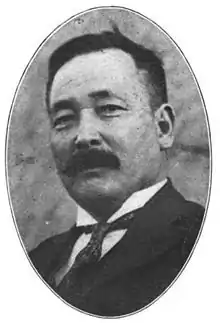George Shima | |
|---|---|
 | |
| Born | Ushijima Kinji (牛島謹爾) 1864 Kurume, Fukuoka, Japan |
| Died | March 27, 1926 (aged 61–62) Los Angeles, California, U.S. |
| Resting place | Japanese Cemetery in Colma, California |
| Occupation | Businessman |
| Known for | Agriculture |
George Shima (1864 – March 27, 1926) was a Japanese American businessman in California who became the first Japanese American millionaire.[1] At one point, he produced about 85% of the state's potato crop,[2] which earned him the nickname "The Potato King".[3][4]
Early life
Born Ushijima Kinji (牛島謹爾) in Kurume, Fukuoka, Japan,[5] he entered a preliminary course at the Tokyo Commercial School (now Hitotsubashi University), but failed the entrance examination for the regular course. He emigrated to San Francisco in 1889 determined to learn English, the subject that gave him the most trouble on the exam.[3]
Career
Upon his arrival in San Francisco, he changed his name to George Shima. He first worked as a domestic servant,[6] then became a migrant farm laborer in the Sacramento Delta for a while. Soon afterward, he turned his eye to management, when he began supplying Japanese farm workers to white farmers. By the late 1890s, he leased some land and began his own farming operations. He was successful enough to purchase some inexpensive swampland (considered undesirable by white American farmers[6]) in the San Joaquin Delta. After draining and diking the land, he found that potatoes grew best in that type of soil, and using corporate management techniques and the latest agricultural technology, began to corner the market in potatoes. By 1913, he had 28,000 acres (113 km2) in production and by 1920, he had 85% of the market share with his "Shima Fancy" brand, valued at more than $18 million ($262,943,522 today).[3]
His business success did not bring him respite from racism, however. In 1909, while trying to purchase a home in Berkeley, he was actively opposed by real estate agents and other homeowners. Despite being the subject of such newspaper headlines as "Yellow Peril in College Town", Shima became active in the community, donating $500 to the local YMCA, and gradually won over his neighbors.[7] Still, the opposition he encountered led him that same year to become the first president of the Japanese Association of America and to unsuccessfully fight the passing of the California Alien Land Law of 1913, which was written to prevent Asians from owning land.[3] The Immigration Act of 1924 prevented immigration from Asia into the U.S. which lead to Shima losing his workforce. Shima decided to return to Japan, tired of the prejudice he faced in the U.S., but he died suddenly during his travels back to Japan.[8]
Death and legacy
In 1926, after a business trip to Los Angeles, he suffered a stroke and died. That same day he was awarded the Fourth Rank Order of the Rising Sun from the Emperor of Japan.[9] He received the award from Hirohito, later known as Emperor Shōwa.[lower-alpha 1] At his funeral, David Starr Jordan, the president of Stanford University, and James Rolph, the Mayor of San Francisco, both served as pallbearers.[3] Shima is buried in the Japanese Cemetery in Colma, California.[10] At the Japanese Cemetery, there is a monument in his honor.[10]
The Shima Center at San Joaquin Delta College honors his legacy.[3] Yoshinobu Hirotsu, a fellow resident of Shima's hometown of Kurume, also raised several hundred thousand yen to set up a life-sized monument to him in a park there in 1999.[5]
See also
- John P. Irish, activist in support of Japanese immigration. Shima was an honorary pallbearer at his funeral.
Notes
- ↑ Although his father, the Emperor Taishō, was nominally on the throne until his death on December 25, 1926, Hirohito had served as regent to his mentally disabled father since 1921.
References
- ↑ Hoobler, Dorothy; Hoobler, Thomas (1995). The Japanese American Family Album. Oxford University Press. p. 64. ISBN 978-0195124231.
- ↑ "'Potato King' Is Dead; George Shima, Japanese Who Made Millions, Dies of a Stroke," New York Times. March 28, 1926
- 1 2 3 4 5 6 Kim, Hyung-chan. (1999). Distinguished Asian Americans: A Biographical Dictionary, p. 316, at Google Books
- ↑ "Japanese farmers of California through industry and skill have made neglected regions fruitful". San Francisco Chronicle. San Francisco, California. 1918-01-16. p. 21.
- 1 2 Hirano, Miki (2007-12-14). "「ポテト王」の魅力伝えたい--広津芳信さん (Mr. Yoshinobu Hirotsu: I want to tell you about the Potato King's charm)". Mainichi Shimbun (in Japanese). Retrieved 2008-01-11.
- 1 2 Hata, Don and Nadine. "George Shima: The Potato King of California" (PDF). Journal of the West. Archived from the original (PDF) on 2012-03-05. Retrieved 2009-12-09.
- ↑ Kawakami, Kiyoshi K. (May 8, 1913), "How California Treats the Japanese" in The Independent Weekly (New York), Vol. 74, No. 3362., p. 1020, at Google Books
- ↑ "Fitz's Stockton: Stockton's 'Potato King': This spud's for you".
- ↑ Yoshimura, Toshio. (1981). George Shima, Potato King and Lover of Chinese Classics, p. 53
- 1 2 Svanevik, Michael; Burgett, Shirley (2017-12-06). "Matters Historical: A bit of old Japan in a Colma cemetery". The Mercury News. Retrieved 2021-10-10.